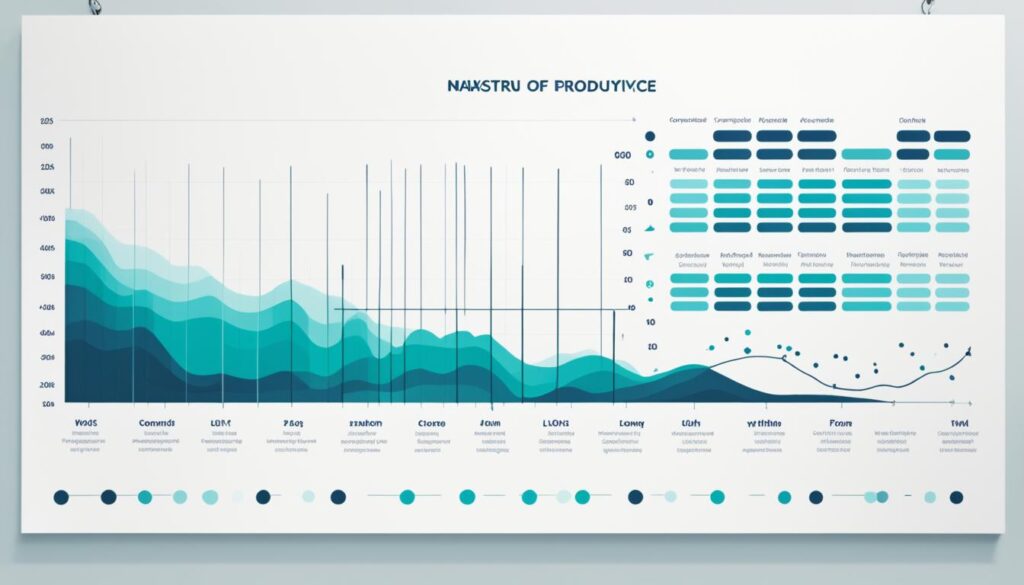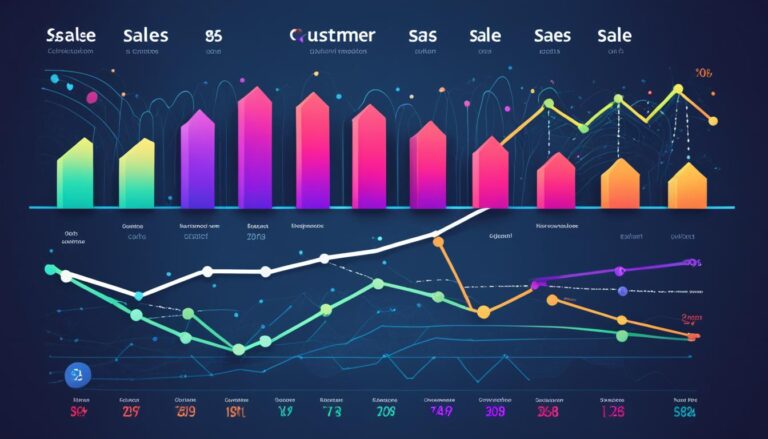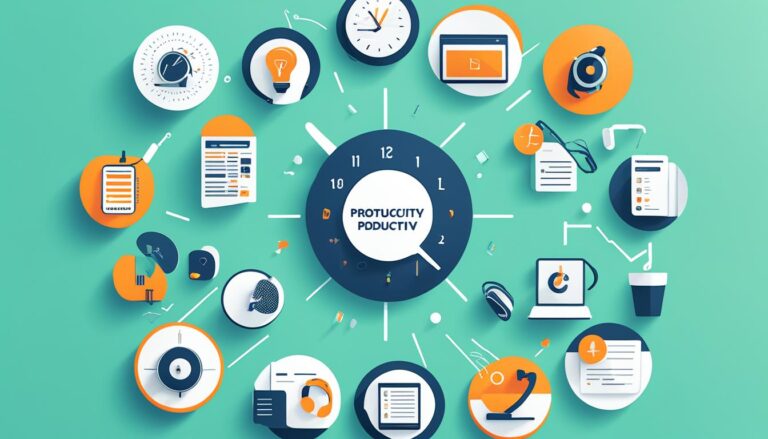Boost Your Workplace Productivity Today!

Are you tired of feeling overwhelmed and unproductive at work? Do you find yourself struggling to meet deadlines and accomplish tasks efficiently? It’s time to unlock the secrets to workplace productivity and transform your workday into a highly productive and fulfilling experience.
In this article, we will delve into proven strategies and techniques that will help you increase your productivity in the workplace. From understanding your natural rhythms and prioritizing tasks to creating a conducive work environment and adopting healthy habits, you can revolutionize the way you work and achieve remarkable results.
So, are you ready to discover the key to unlocking your full potential and revolutionizing your productivity at work? Let’s dive in!
Key Takeaways:
- Understanding your natural rhythms can help you allocate your workload effectively.
- Setting realistic priorities and minimizing distractions are crucial for staying focused and efficient.
- Multitasking is not an effective strategy – focus on one task at a time for improved productivity.
- Adopting healthy habits and creating an optimal work environment can significantly enhance your productivity.
- Overcoming perfectionism and focusing on progress can help you achieve greater productivity and success.
Understanding the Science of Productivity
According to workplace productivity coach and speaker, Dr. Melissa Gratias, productivity is influenced by natural peaks and valleys in our focus and motivation driven by our ultradian rhythms. By identifying your most energized periods during the day, or “biological prime time,” you can allocate your workload effectively. Plan complex or creative tasks for your peak hours and save less demanding tasks for times when your energy levels are lower.
Understanding your ultradian rhythms can significantly impact your workplace productivity. These rhythmic cycles, which occur roughly every 90-120 minutes, affect your cognitive and physiological functioning. During your peak energy periods, your brain is better equipped to handle complex tasks and make critical decisions.
By capitalizing on these natural cycles, you can optimize your productivity and achieve better results in less time. Here are some tips to harness the power of your ultradian rhythms:
- Identify your biological prime time: Pay attention to when you feel most alert, focused, and productive throughout the day. This could be in the morning, midday, or even in the evening. Once you pinpoint your biological prime time, schedule your most challenging and important tasks during this period.
- Plan and prioritize: Make a list of your tasks and assign them to specific time slots based on your energy levels. Reserve your peak energy periods for tasks that require creativity, problem-solving, and critical thinking. Save routine or less demanding tasks for times when your energy naturally dips.
- Take breaks: It’s essential to rest and recharge to maintain productivity over the long term. Use your natural energy cycles to incorporate regular breaks into your schedule. Taking short breaks and engaging in activities that help you relax and recharge can help prevent burnout and improve overall productivity.
Understanding the science of productivity and aligning your work with your natural energy rhythms can significantly improve your workplace efficiency. By strategically planning and prioritizing your tasks, you can make the most of your productive hours and achieve better results.
Below is a table that outlines the typical ultradian rhythm cycles:
| Ultradian Rhythm Cycle | Description |
|---|---|
| High Energy | A period of heightened alertness and focus |
| Moderate Energy | A period of decreased energy compared to the high energy phase |
| Low Energy | A period of reduced alertness and decreased cognitive functioning |
| Recovery | A period of rest and rejuvenation before the next ultradian cycle begins |

Prioritizing Tasks for Maximum Efficiency
Setting realistic priorities is crucial for boosting productivity. Instead of overwhelming yourself with an extensive to-do list, focus on selecting between five and nine tasks that you want to make progress on each day. This way, you can dedicate your time and energy to the most important and impactful tasks.
One effective approach to prioritizing tasks is the 1-3-5 rule. This rule encourages you to choose one big task, three medium tasks, and five small tasks for each day. By following this rule, you ensure a balanced workload that allows you to tackle significant projects while still accomplishing smaller, more manageable tasks.
The Eisenhower Matrix is a valuable tool that can help you further prioritize your tasks. This matrix categorizes tasks into four quadrants based on their urgency and importance, allowing you to determine which tasks deserve your immediate attention and which can be delegated or eliminated. By utilizing the Eisenhower Matrix, you can focus on the tasks that truly matter and avoid wasting time on unimportant or low-priority tasks.
To minimize distractions and maintain focus, it’s essential to be mindful of both self-imposed and environmentally imposed distractions. Self-imposed distractions can include excessive use of social media or constantly checking email notifications. On the other hand, environmentally imposed distractions can come from noisy coworkers or a cluttered workspace.
Here are some tips to help you minimize distractions:
- Put away your phone or use app blockers to limit social media access during work hours.
- Close unnecessary browser tabs or use website blockers to prevent accessing non-work-related websites.
- Create a designated workspace that is free from clutter and distractions.
- Use noise-canceling headphones or play white noise to drown out background noise.
By prioritizing your tasks and minimizing distractions, you can optimize your productivity levels and accomplish more throughout the day.

| Methods | Benefits |
|---|---|
| The 1-3-5 rule | – Ensures a balanced workload – Accomplishes both big and small tasks – Provides a sense of accomplishment |
| The Eisenhower Matrix | – Identifies urgent and important tasks – Helps prioritize tasks effectively – Eliminates low-priority tasks |
| Minimizing distractions | – Enhances focus and concentration – Increases productivity levels – Improves task completion |
Overcoming Multitasking and Maintaining Focus
Contrary to popular belief, multitasking is not an effective productivity strategy. Research has shown that the human brain is incapable of multitasking and instead engages in task switching. To improve focus and productivity, it is essential to prioritize and focus on one task at a time.
One effective technique to maintain focus is through the practice of external self-talk. By verbally stating the task you are going to work on, you reinforce the commitment and increase your concentration on that specific task. This simple technique helps to keep distractions at bay and promotes a deeper level of engagement.
Another strategy to enhance productivity is task batching. Grouping similar tasks together allows you to streamline your workflow and minimize the mental strain of constantly shifting between different types of tasks. By dedicating focused time blocks to specific types of tasks, you can harness your cognitive resources more efficiently and accomplish more in less time.
To visualize the benefits of task batching, consider the following example:
| Task Type | Time Spent |
|---|---|
| Emails | 30 minutes |
| Social Media Management | 1 hour |
| Report Writing | 2 hours |
| Meetings | 1 hour |
By allocating designated time blocks to specific types of tasks, you can maximize your focus and productivity. This strategy allows for better concentration, reduces the mental strain of task switching, and enhances overall work efficiency.
Embracing effective time management techniques, such as focusing on one task at a time and implementing task batching, can significantly improve your productivity and allow you to accomplish more in your workday.
The Role of Healthy Habits in Productivity
Adopting healthy habits can have a significant impact on productivity. When it comes to optimizing your performance in the office, incorporating simple habits into your routine can make all the difference. By prioritizing your well-being, you can boost your energy levels, enhance focus, and maintain productivity throughout the day.
Stay Hydrated and Energized
Start your day off right by drinking a glass of water before reaching for that morning cup of coffee. Keeping yourself hydrated is essential for maintaining optimal brain function and productivity. Research suggests that even mild dehydration can lead to decreased cognitive performance, affecting your motivation and concentration (1).
Take Regular Breaks
While it may seem counterintuitive, taking regular breaks can actually improve productivity. Working for extended periods without breaks can lead to decreased focus, increased mental fatigue, and reduced overall efficiency. Implementing the Pomodoro Technique, a time management method, can help you stay on track and maintain high productivity levels. The technique involves working for 25 minutes and then taking a short break, allowing you to recharge and refocus (2).
Include Physical Activity and Stretching
Physical activity is not only important for your overall health, but it can also enhance your productivity. Incorporate brief stretches or quick exercises during your breaks to improve blood flow and increase energy levels. These movements can help combat the negative effects of sitting for prolonged periods and revive your focus (3).
| Healthy Habit | Benefits |
|---|---|
| Drinking water | Improved cognitive function and focus |
| Taking regular breaks | Enhanced mental clarity and reduced fatigue |
| Including physical activity | Increased energy levels and improved concentration |
Remember, incorporating healthy habits into your daily routine is a long-term investment in your well-being and productivity. By taking care of yourself physically and mentally, you can optimize your performance and achieve success in the workplace.

Creating an Optimal Work Environment
Your work environment plays a crucial role in your productivity. By optimizing your workspace and implementing a few key strategies, you can significantly improve workplace efficiency, enhance focus, and boost motivation.
Organize and Declutter
Start by organizing and decluttering your workspace. Remove any unnecessary items and keep your desk tidy. Having a clean workspace can help minimize distractions and reduce the time spent searching for important documents or supplies.
Add Pops of Color and Live Plants
Add pops of color and live plants to your work environment. Studies have shown that adding vibrant colors can enhance mood and productivity. Incorporating plants into your workspace can also improve air quality and create a calming atmosphere.
Maximize Natural Light
Position your desk near a window to benefit from natural light. Natural light has been proven to increase alertness, improve mood, and enhance productivity. If natural light is limited, consider using full-spectrum lighting that mimics natural sunlight.
Invest in Ergonomic Desk Accessories
To create a comfortable and efficient work experience, invest in ergonomic desk accessories. Ergonomic chairs, adjustable desks, and ergonomic keyboards can help reduce strain on your body and minimize the risk of musculoskeletal disorders.
Switch Up Your Environment
Vary your work environment occasionally to introduce novelty and stimulate creativity. If possible, work in different areas of your office or consider coworking spaces. Changing your surroundings can help prevent boredom and increase motivation.

Comparison of Ergonomic Desk Accessories
| Product | Description | Price |
|---|---|---|
| Ergonomic Office Chair | A chair designed to support proper posture and provide back and lumbar support. | $300 |
| Adjustable Standing Desk | A desk that allows you to switch between sitting and standing positions throughout the day. | $500 |
| Ergonomic Keyboard | A keyboard designed to reduce strain on your wrists and hands during typing. | $100 |
Investing in ergonomic desk accessories can greatly improve comfort and productivity. Consider the options available and choose the accessories that best suit your needs and budget.
Overcoming Perfectionism and Focusing on Progress
Perfectionism can be a productivity roadblock, causing individuals to delay starting tasks and becoming overly fixated on fine-tuning their work. To enhance productivity and avoid the pitfalls of perfectionism, consider implementing the following strategies:
1. Set Time Limits or Timeboxing
By setting specific time limits for tasks or using timeboxing techniques, you can overcome perfectionistic tendencies and shift your focus to making progress rather than striving for flawless outcomes. Allotting a predetermined amount of time for each task helps you maintain momentum and prevent excessive time spent on minute details.
2. Break Goals into Manageable Tasks
Large, daunting goals can contribute to perfectionistic tendencies. Instead, break down big goals into smaller, more manageable tasks. This approach allows you to focus on completing each individual task, step-by-step, leading to a sense of accomplishment and increased momentum. Celebrate your progress along the way, acknowledging that every task completed is a step closer to achieving your overall goal.
3. Embrace a Growth Mindset
Developing a growth mindset involves understanding that mistakes and imperfections are natural parts of the learning process. Embrace the idea that progress is more important than perfection. View setbacks and failures as opportunities for growth and learning rather than indications of personal shortcomings. Cultivating a growth mindset can help you maintain a positive outlook and achieve greater productivity.
Remember, aiming for progress over perfection allows you to make significant strides in your work while avoiding the pitfalls of perfectionism. By setting time limits, breaking tasks into manageable chunks, and adopting a growth mindset, you can enhance your productivity and achieve your goals more effectively.
Conclusion
Improving workplace productivity is essential for achieving success in your professional life. By implementing effective strategies and techniques, you can significantly enhance your productivity and make the most of your workday.
Understanding your natural rhythms and identifying your most energized periods allows you to prioritize important tasks and allocate them to your peak hours. By setting realistic goals and minimizing distractions, you can maintain focus and stay on track throughout the day.
Adopting healthy habits, creating an optimal work environment, and overcoming perfectionism are also key factors in improving productivity. Taking regular breaks, organizing your workspace, and incorporating natural light and ergonomic accessories contribute to a more efficient and comfortable work experience.
Remember, productivity is a continuous process, and it’s important to continually evaluate and optimize your methods. By incorporating these strategies into your work routine, you can effectively boost workplace productivity and achieve your goals.





